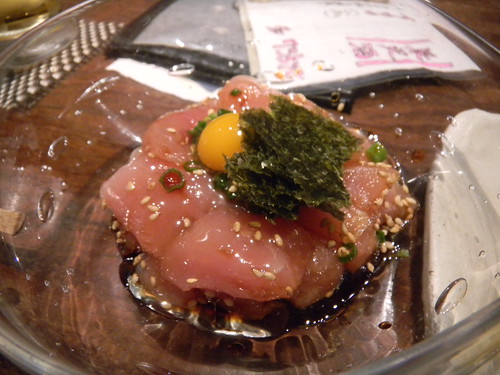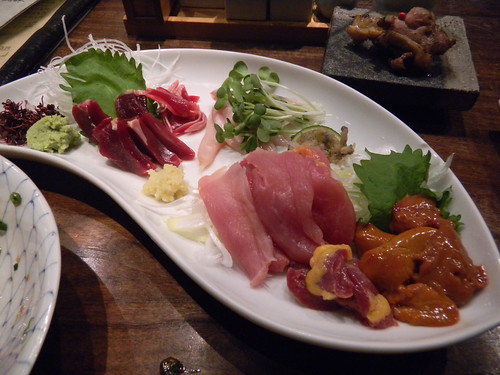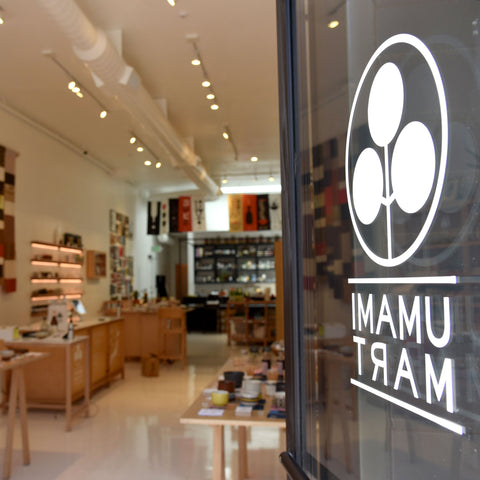
"HELP! I ate three bites of raw chicken, am I going to get sick?!"
"I had chicken for dinner but it was pink. I ate it, but I am worried now. What should I do?"
"Warning: FDA strongly advises chicken to be cooked completely before consumption."
These are what comes up on Google when you type, "raw chicken."
Japanese people eat raw chicken just like raw fish. I had the hardest time understanding this until recently, since in America everyone is so afraid of salmonella. In every cooking show chefs warn you to make sure the chicken is cooked through, and cross-contaminated when dealing with chicken.
After reading endless posts and information on chicken, I came to the conclusion that Western mass chicken production facilities are so fucked up that eating it raw is not an option unless you want to kill yourself. Look at their breasts-- even Anna Nicole Smith feels her boobs are smaller compared to them. Apparently, most mass-produced chickens can't even stand still because they are way overgrown by all the steroids and drugs. Chickens are the most popular meat in this country, but its cooking standards are telling us that chickens are disgusting animals. Watching
Fast Food Nation is a good way to be educated about scary meat production in this country.
So when I went to a yakitori restaurant in Kyoto, it was very weird to see all the "sashimi" items on the menu. I was a bit hesitant in the beginning, but my friend insisted at least we should order one raw item. So we got sasami (chicken tender). It was dressed with sesame oil, sesame, soy sauce, bit of chilli, topped with quail egg and nori.

I was scared, but it was delicious. Sweet and soft, no weird raw taste at all. Just awesome. These chickens are not regular ones we know. Usually, chickens live for about 60 days, but these ladies have lived an average of 700 days. Yes, almost two years, compared to two months. They are passed their egg producing time, so all the nutrition they get stays inside their body, hence they taste good. Sounds just like the post-egg-producing ladies in the human world. No wonder
Cougar Town is such a big hit.
After the sasami, I was like, "Let's order more sashimi!" So we ordered four different kinds. From left to right, gizzard, breast (under kaiware radish), thigh, and liver.

We were instructed to use different sauce for each kind as well. Gizzard with soy sauce and grated ginger, breast meat with soy sauce and wasabi, thigh meat with hot mustard and salt, and liver with sesame oil and salt. I've had food moments in my life when I was blown away by the chef's creativity, freshness of ingredients, but this was like nothing I had experienced.
The gizzards were crunchy, but did not have that, "too raw flavor", nor was it bloody (which you can imagine from the color of the meat). I can't compare this with anything else, since the texture was such a new and unknown kind to me, but definitely worth a try. Breast and thigh meats were similar to the sasami. So sweet, but texture was definitely distinct. The sasami was soft, while the breast meat was firm, and the thigh meat even firmer. Given the thigh meat is around legs, it's understandable that thigh meat would be the firmest. Just tasting these different textures was a lot of fun.
And the liver was beyond description. Sweet, not gamey at all. So buttery and it just melted in my mouth. Sesame oil and salt dipping sauce definitely worked its magic here. Look how golden the liver looks!
I know some of you may be gagging over this post, and I don't blame you. Just like fish sashimi, you need to be picky about where you have these dishes. I know
Yakitori Totto served chicken raw when they opened in 2006, but most review said they were too scared to try it, so the item disappeared from the menu. I am sure the chicken
Erin had killed when she quit vegetarianism could have been eaten raw. That's the kind of environment they need to be raised.
If you go to Japan, and have a chance to go to yakitori restaurant, I highly recommend you try this. Who knows, this could be the next big hit of must try in NYC, especially with all the hype of local harvesting and whatnot. I can totally see
David Chang serving this.
Below picture has nothing to do with chicken, but I paid 1,000 yen ($12, no refill) for this cup of coffee in Tokyo, so I have to post this. Pretty porcelain cup and everything, but really, $12 for a cup of coffee is a bit stretch. By the way, I wanted Blue Mountain, but that was $14, so I ordered the regular.

 "HELP! I ate three bites of raw chicken, am I going to get sick?!"
"I had chicken for dinner but it was pink. I ate it, but I am worried now. What should I do?"
"Warning: FDA strongly advises chicken to be cooked completely before consumption."
These are what comes up on Google when you type, "raw chicken."
Japanese people eat raw chicken just like raw fish. I had the hardest time understanding this until recently, since in America everyone is so afraid of salmonella. In every cooking show chefs warn you to make sure the chicken is cooked through, and cross-contaminated when dealing with chicken.
After reading endless posts and information on chicken, I came to the conclusion that Western mass chicken production facilities are so fucked up that eating it raw is not an option unless you want to kill yourself. Look at their breasts-- even Anna Nicole Smith feels her boobs are smaller compared to them. Apparently, most mass-produced chickens can't even stand still because they are way overgrown by all the steroids and drugs. Chickens are the most popular meat in this country, but its cooking standards are telling us that chickens are disgusting animals. Watching Fast Food Nation is a good way to be educated about scary meat production in this country.
So when I went to a yakitori restaurant in Kyoto, it was very weird to see all the "sashimi" items on the menu. I was a bit hesitant in the beginning, but my friend insisted at least we should order one raw item. So we got sasami (chicken tender). It was dressed with sesame oil, sesame, soy sauce, bit of chilli, topped with quail egg and nori.
"HELP! I ate three bites of raw chicken, am I going to get sick?!"
"I had chicken for dinner but it was pink. I ate it, but I am worried now. What should I do?"
"Warning: FDA strongly advises chicken to be cooked completely before consumption."
These are what comes up on Google when you type, "raw chicken."
Japanese people eat raw chicken just like raw fish. I had the hardest time understanding this until recently, since in America everyone is so afraid of salmonella. In every cooking show chefs warn you to make sure the chicken is cooked through, and cross-contaminated when dealing with chicken.
After reading endless posts and information on chicken, I came to the conclusion that Western mass chicken production facilities are so fucked up that eating it raw is not an option unless you want to kill yourself. Look at their breasts-- even Anna Nicole Smith feels her boobs are smaller compared to them. Apparently, most mass-produced chickens can't even stand still because they are way overgrown by all the steroids and drugs. Chickens are the most popular meat in this country, but its cooking standards are telling us that chickens are disgusting animals. Watching Fast Food Nation is a good way to be educated about scary meat production in this country.
So when I went to a yakitori restaurant in Kyoto, it was very weird to see all the "sashimi" items on the menu. I was a bit hesitant in the beginning, but my friend insisted at least we should order one raw item. So we got sasami (chicken tender). It was dressed with sesame oil, sesame, soy sauce, bit of chilli, topped with quail egg and nori.
 I was scared, but it was delicious. Sweet and soft, no weird raw taste at all. Just awesome. These chickens are not regular ones we know. Usually, chickens live for about 60 days, but these ladies have lived an average of 700 days. Yes, almost two years, compared to two months. They are passed their egg producing time, so all the nutrition they get stays inside their body, hence they taste good. Sounds just like the post-egg-producing ladies in the human world. No wonder Cougar Town is such a big hit.
After the sasami, I was like, "Let's order more sashimi!" So we ordered four different kinds. From left to right, gizzard, breast (under kaiware radish), thigh, and liver.
I was scared, but it was delicious. Sweet and soft, no weird raw taste at all. Just awesome. These chickens are not regular ones we know. Usually, chickens live for about 60 days, but these ladies have lived an average of 700 days. Yes, almost two years, compared to two months. They are passed their egg producing time, so all the nutrition they get stays inside their body, hence they taste good. Sounds just like the post-egg-producing ladies in the human world. No wonder Cougar Town is such a big hit.
After the sasami, I was like, "Let's order more sashimi!" So we ordered four different kinds. From left to right, gizzard, breast (under kaiware radish), thigh, and liver.
 We were instructed to use different sauce for each kind as well. Gizzard with soy sauce and grated ginger, breast meat with soy sauce and wasabi, thigh meat with hot mustard and salt, and liver with sesame oil and salt. I've had food moments in my life when I was blown away by the chef's creativity, freshness of ingredients, but this was like nothing I had experienced.
The gizzards were crunchy, but did not have that, "too raw flavor", nor was it bloody (which you can imagine from the color of the meat). I can't compare this with anything else, since the texture was such a new and unknown kind to me, but definitely worth a try. Breast and thigh meats were similar to the sasami. So sweet, but texture was definitely distinct. The sasami was soft, while the breast meat was firm, and the thigh meat even firmer. Given the thigh meat is around legs, it's understandable that thigh meat would be the firmest. Just tasting these different textures was a lot of fun.
And the liver was beyond description. Sweet, not gamey at all. So buttery and it just melted in my mouth. Sesame oil and salt dipping sauce definitely worked its magic here. Look how golden the liver looks!
I know some of you may be gagging over this post, and I don't blame you. Just like fish sashimi, you need to be picky about where you have these dishes. I know Yakitori Totto served chicken raw when they opened in 2006, but most review said they were too scared to try it, so the item disappeared from the menu. I am sure the chicken Erin had killed when she quit vegetarianism could have been eaten raw. That's the kind of environment they need to be raised.
If you go to Japan, and have a chance to go to yakitori restaurant, I highly recommend you try this. Who knows, this could be the next big hit of must try in NYC, especially with all the hype of local harvesting and whatnot. I can totally see David Chang serving this.
Below picture has nothing to do with chicken, but I paid 1,000 yen ($12, no refill) for this cup of coffee in Tokyo, so I have to post this. Pretty porcelain cup and everything, but really, $12 for a cup of coffee is a bit stretch. By the way, I wanted Blue Mountain, but that was $14, so I ordered the regular.
We were instructed to use different sauce for each kind as well. Gizzard with soy sauce and grated ginger, breast meat with soy sauce and wasabi, thigh meat with hot mustard and salt, and liver with sesame oil and salt. I've had food moments in my life when I was blown away by the chef's creativity, freshness of ingredients, but this was like nothing I had experienced.
The gizzards were crunchy, but did not have that, "too raw flavor", nor was it bloody (which you can imagine from the color of the meat). I can't compare this with anything else, since the texture was such a new and unknown kind to me, but definitely worth a try. Breast and thigh meats were similar to the sasami. So sweet, but texture was definitely distinct. The sasami was soft, while the breast meat was firm, and the thigh meat even firmer. Given the thigh meat is around legs, it's understandable that thigh meat would be the firmest. Just tasting these different textures was a lot of fun.
And the liver was beyond description. Sweet, not gamey at all. So buttery and it just melted in my mouth. Sesame oil and salt dipping sauce definitely worked its magic here. Look how golden the liver looks!
I know some of you may be gagging over this post, and I don't blame you. Just like fish sashimi, you need to be picky about where you have these dishes. I know Yakitori Totto served chicken raw when they opened in 2006, but most review said they were too scared to try it, so the item disappeared from the menu. I am sure the chicken Erin had killed when she quit vegetarianism could have been eaten raw. That's the kind of environment they need to be raised.
If you go to Japan, and have a chance to go to yakitori restaurant, I highly recommend you try this. Who knows, this could be the next big hit of must try in NYC, especially with all the hype of local harvesting and whatnot. I can totally see David Chang serving this.
Below picture has nothing to do with chicken, but I paid 1,000 yen ($12, no refill) for this cup of coffee in Tokyo, so I have to post this. Pretty porcelain cup and everything, but really, $12 for a cup of coffee is a bit stretch. By the way, I wanted Blue Mountain, but that was $14, so I ordered the regular.





Comments (20)
Now we just need Kayoko to do a write up of Ippuku and try out West Coast chicken Sashimi!
The problem is most of Japan’s food is imported (a majority from China). I would not trust the food standards of China over the US.
http://search.japantimes.co.jp/cgi-bin/nn20080226i1.html
What? Ippuku has chicken sashimi? Kayoko, come on already, you manage that place, don’t ya?
Man, is that what ya’ll want? Well, I suppose it’s not all that out of the question, although yes, I work there once a week (I no longer manage Ippuku, that was temporary).
OR we could just get a Foster Farms chicken, thaw it, slice it up ourselves and try some awesome grocery store chicken sashimi!
Even Foster Farms says this..
Our Commitment to Food Safety
For more than 70 years, Foster Farms as provided consumers of the West with fresh, natural chicken. Food safety has always been our highest priority.
Foster Farms employs a Strategic Sampling program above and beyond USDA regulations to monitor the incidence of salmonella and campylobacter; microbial bacteria that naturally exist in raw poultry products. Over the course of 2009 the company has tested, at its plants, more than 6000 samples of chicken at an intermediate point in the production process, and found the incidence of salmonella to be 3.3 percent. The comprehensive testing procedures used by Foster Farms are based on repeatable, verifiable scientific methodologies that have been validated by the USDA’s Food Safety Assessment program. The most recent, independent testing by the USDA in 2009 found incidence levels of 3.4 percent, further validating the Foster Farms testing. The USDA considers levels below 5% to demonstrate excellent microbiological control.
Foster Farms has been at the forefront of adding procedures at the ranch and plant level to reduce the incidence of salmonella and campylobacter. Its food safety strategy includes vaccination of breeder flocks, hatchery sanitation programs, and a “multiple-hurdle” approach at the processing plant to better ensure bacteria control. The company continues to aggressively seek out and test new methods of microbial control and eradication.
Experts are in complete agreement that chicken properly handled and cooked to a temperature of 165 degrees is completely safe, and the presence of any bacteria, fully eradicated. Preparation guidelines and safe handling instructions are available on every Foster Farms package and are also available at the company’s website at
@Kayoko: Please forget to invite me to that gathering.
@Yamohomo: Wow, I can’t believe Fosters Farm actually writes that out. Newfound respect.
@Adam: Let’s do a sort of “Man vs. Food” type Umamiventure. Adam vs. Chicken Sashimi, holla!
@Mike: I’m gonna go out on a limb here and say that anywhere they serve chicken sashimi— in Japan, US or otherwise, they are most likely using the freshest chicken they can get there hands on. Ie, not from the grocery store.
Yama or Yoko, any thoughts on meat sourcing at restaurants in Japan?
I am sure chain restaurants rely on imports in Japan, but individual restaurants, such as the place where I went must get their produce from a respected source. Having said that, there are many cases where sources are marked wrongfully (some unknown beef labeled as Kobe, etc.). When you want to have chicken (or fish) sashimi, you have to trust the restaurant’s judgment, as well as reputation. When you hear “chicken sashimi at this restaurant is to die for”, the chance is, it’s ok to eat them raw.
I wish I knew where the place I used to work at got their meats. But I agree with what Yamahomo says. A lot of the chain grocers and restaurants get their beef from elsewhere. Even so, they were reluctant to import American beef for a long time, so even the chains have somewhat of a standard. Yoshinoya was hurting bad when Japan started prohibiting the import of US beef and opted for Aussie beef instead. But before I left Tokyo in Jan 2010, there were a lot of US beef commercials in the subways. US beef was definitely back in force. It all seems very political.
I am really into how Umamimart is on the forefront of debunking the whole raw chicken thing. It’s about time someone did it.